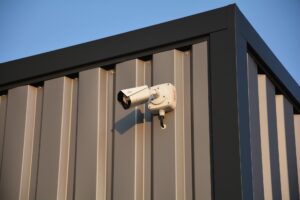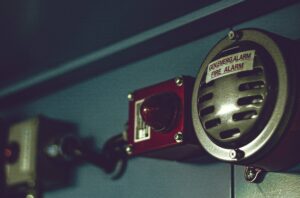Fire Alarm Testing A Lifesaver You Can’t Ignore
Fire alarm testing isn’t just about following rules. It’s a critical safety step that directly affects how likely people are to survive a fire. Regular testing makes sure fire alarm systems function properly when they’re needed most. This early warning gives people valuable time to escape safely before conditions become life-threatening.
Regularly testing fire alarm systems greatly reduces fire-related deaths. It’s also the law for both homes and businesses, a matter of fire safety legislation. How often you need to test depends on the building type. Commercial premises require more frequent checks than homes.
Key Points to Remember
- Working smoke alarms reduce fire death risk by 55 percent, according to NFPA data.
- Home alarms need monthly testing, and you should replace the batteries at least once a year.
- Commercial buildings require weekly call point testing (pull stations) and annual professional inspections.
- All smoke alarms should be replaced every 10 years, no matter how well they seem to be working properly.
- Keeping records of testing is crucial for insurance compliance, and it may be a legal requirement.
Why Testing Fire Alarms Saves Lives
The statistics are clear. Working smoke alarms reduce the risk of dying in a house fire by more than half. Despite this, the National Fire Protection Association (NFPA) reports that three out of five home fire deaths happen in places without working smoke alarms. These aren’t just statistics because they represent real people whose lives could be saved with proper fire safety.
Early fire detection systems provide critical escape time. When a fire starts, you might have as little as two minutes to get out safely. A properly working fire alarm system can be the difference between life and death because it alerts people at the earliest stages of a fire.
Regular testing isn’t just about meeting code requirements or fire safety regulations. It’s about making sure these life-saving devices work when you need them. Many people assume their fire alarms are working simply because they’re installed, but without testing, there’s no way to be sure they’ll actually sound during an emergency, in the event of a fire.
Home Fire Alarm Testing, What You Need to Know
For homeowners, maintaining fire alarm systems is fairly simple, but it requires consistent attention. Monthly testing is the recommended minimum for all home smoke alarms. This involves pressing the test button on each alarm and making sure it makes a loud sound. The alarm should sound clearly.
You should replace batteries at least once a year, or immediately when you hear a low-battery chirp. Many fire safety experts suggest changing batteries when daylight saving time changes. This makes it easier to remember. Also, all smoke alarms, even hardwired ones with battery backups, should be completely replaced every 10 years. You can usually find the manufacture date printed on the back of the device.
Different alarm types need specific testing methods.
- Smoke detectors should be tested by pressing and holding the test button until the alarm sounds (usually 3-5 seconds). You should test your smoke alarms this way.
- Heat alarms should have their testing done via a manufacturer-approved test spray or follow the specific testing instructions.
- Carbon monoxide alarms should be tested by pressing the test button monthly, and you should replace the alarm according to the manufacturer’s guidelines.
While monthly self-testing is good for basic maintenance, it is recommended to have an annual professional inspection. This ensures complete coverage and helps identify any problems you might not notice, helping to identify any issues.
Commercial Building Rules, More Frequent Testing is Required
Commercial buildings have stricter rules for fire alarm testing. This is because they have more people and a greater potential risk. Unlike homes, commercial fire alarm systems must have weekly fire alarm tests of manual call points (also called pull stations). Each week, a different call point should be tested in turn to make sure all are checked regularly.
Quarterly inspections by qualified technicians are needed to examine fire alarm system components like control panels, notification devices, and initiating devices. These more thorough checks help identify issues that might not be apparent during basic weekly tests.
A full system-wide test must happen at least once a year, and this includes detailed records of all findings, usually stored in a log book. This complete assessment includes:
- Testing every part of the system.
- Making sure devices communicate properly.
- Checking backup power supplies.
- Ensuring signals are sent correctly to monitoring services, such as an alarm receiving centre.
- Confirming integration with other building systems like HVAC and door controls.
Any faulty parts found during testing must be replaced right away. This maintains compliance with regulations and ensures proper fire protection. These professional inspections create important records for insurance and regulatory compliance. A competent person should carry these out.
Legal Standards and Compliance
Fire alarm testing requirements are based on established codes and standards. The British Standard BS 5839 (BS 5839) is the main authority on fire detection and fire alarm systems in the United Kingdom. It’s updated regularly to include new technology and safety information. BAFE SP203-1 is also an important accreditation standard.
Local building codes and fire rules can vary significantly by area. They often have additional requirements beyond national standards, as outlined in the British Standard BS. It’s important to check with your local fire marshal or building department to understand the specific rules for your location. The Regulatory Reform (Fire Safety) Order 2005, and legislation covering fire safety, outline your obligations, with Article 17 being very important to be aware of.
Insurance companies frequently require fire protection standards that go beyond minimum legal requirements. If you don’t meet these standards, you might have higher premiums or even be denied coverage after a fire. The financial consequences of not complying can be serious. Some areas have fines exceeding £10,000 for major violations. Building owners have a responsibility to understand these rules.
Building owners and property managers should maintain thorough records of all testing and maintenance and repairs to demonstrate compliance during inspections or following incidents. These records can prove invaluable for legal protection and insurance claims.
Common Problems and Troubleshooting
Even with regular testing, fire alarm systems can have problems. Dead batteries are a major cause of alarm failures. The NFPA reports that 17 percent of home fire deaths happen in places where smoke alarms were present but not working, and dead or missing batteries were the main reason.
Dust and debris inside alarm sensors are another common problem. They can cause sensitivity issues and false alarms. In commercial buildings, dust is actually the top cause of false alarms. This can lead to “alarm fatigue,” where people start to ignore alerts.
For hardwired systems, faulty wiring can create occasional problems that are hard to diagnose without professional tools. Signs of potential wiring issues include:
- Alarms that sound briefly and then stop.
- Inconsistent performance during testing.
- Alarm control panels showing trouble codes, which indicate a fault.
- Unexplained power problems affecting multiple devices.
Age-related wear and tear affects all alarm types, no matter the quality. Sensor sensitivity naturally decreases over time. This is why replacement every 10 years is crucial, even if the alarm seems to be in working order during tests.
The Consequences of Ignoring Fire Alarm Testing
The consequences of poor fire alarm testing go far beyond fines. According to NFPA data, the United States has an average of 358,500 home structure fires each year. These fires result in financial losses exceeding $12.9 billion in a recent year.(While this is US data, it demonstrates the scale of the potential issue).
Insurance companies may refuse claims if they find that fire alarm systems weren’t properly maintained. Most policies require following fire safety codes and regularly maintaining protection systems. After a fire, insurance adjusters usually review maintenance records to check for compliance.
Legal liability for property owners who neglect testing can be substantial, especially in commercial or multi-family buildings. If a fire causes injury or death, and investigations show poor alarm testing, the property owner could face lawsuits and even criminal charges in extreme cases.
Beyond the immediate financial impact, businesses that have fires often face long-term problems. These include extended downtime, loss of customers, and damage to their reputation, problems which can take years to recover from.
Best Practices for Fire Safety
I’ve found that keeping detailed testing and maintenance logs (log book) for all alarm systems is one of the most effective practices for ensuring fire safety compliance. These records should include dates, the specific parts tested, the results, and any actions taken to fix problems. A ‘spot check’ can also be completed.
Educating everyone in the building about alarm procedures and escape routes is equally important. Regular fire drills help reinforce these lessons and find potential problems with escape plans before a real emergency.
Statistics show a 50 percent reduction in fire-related deaths when complete fire safety plans are in place. These plans should include:
- Clear escape routes with accessible exits.
- Designated meeting places outside the building.
- Procedures for helping people with limited mobility, such as auto closing doors.
- Regular training on using fire extinguishers for appropriate staff.
- Contact information for emergency services.
Investing in professional inspections can extend a system’s life by 5-10 years. It also ensures all parts are in top working order and helps identify any issues. The cost of these inspections is small compared to the potential losses from a system failing during a fire.
New Technologies in Fire Alarm Testing
The fire safety industry is constantly evolving. New technologies are improving testing efficiency and system reliability. Smart alarms with self-testing and smartphone connections now allow remote monitoring and provide instant alerts when problems occur.
IoT-connected systems offer real-time monitoring and alerts. This allows for a faster response to potential problems. These systems can track battery life, sensor sensitivity, and overall system health without needing manual checks.
For professional inspections, special testing equipment now provides more accurate diagnoses. These tools can find subtle problems that might be missed during standard visual inspections or basic functional tests.
Cloud-based documentation systems are making it easier to keep compliance records. These platforms automatically track testing schedules, store inspection results, and generate reports for regulatory submissions. This reduces the administrative work of fire safety management.
As these technologies become more available, they’re changing how we approach fire safety and they’re making complete protection more attainable for both homes and businesses. If you’d like to know more, please get in touch.
Sources
ajax.systems – How Often Should Fire Alarms Be Tested
sf-fire.org – Fire Safety Guidelines
eastern-time.com – Fire Alarm System Compliance for Commercial Buildings
in.gov – Fire Prevention and Building Safety Commission Rules
pointmonitor.com – How Often Do Commercial Fire Alarms Need To Be Tested
ajax.systems – How Often Should Fire Alarms Be Tested
sf-fire.org – Fire Safety Guidelines
eastern-time.com – Fire Alarm System Compliance for Commercial Buildings
in.gov – Fire Prevention and Building Safety Commission Rules
pointmonitor.com – How Often Do Commercial Fire Alarms Need To Be Tested












